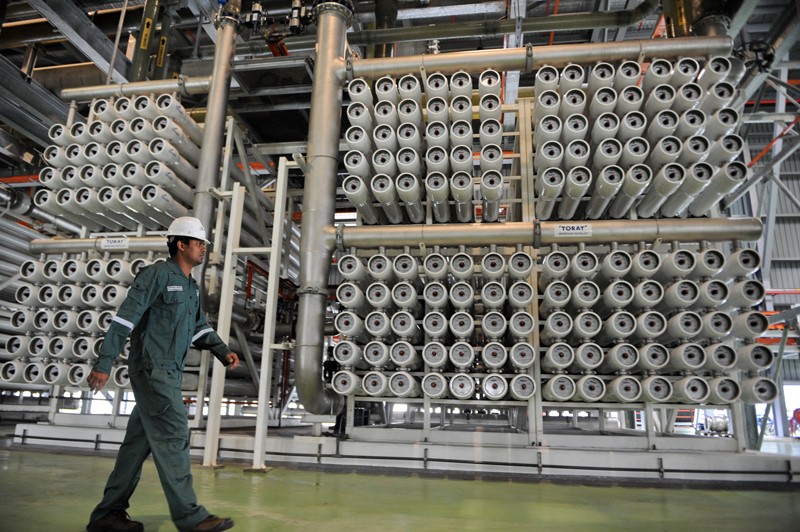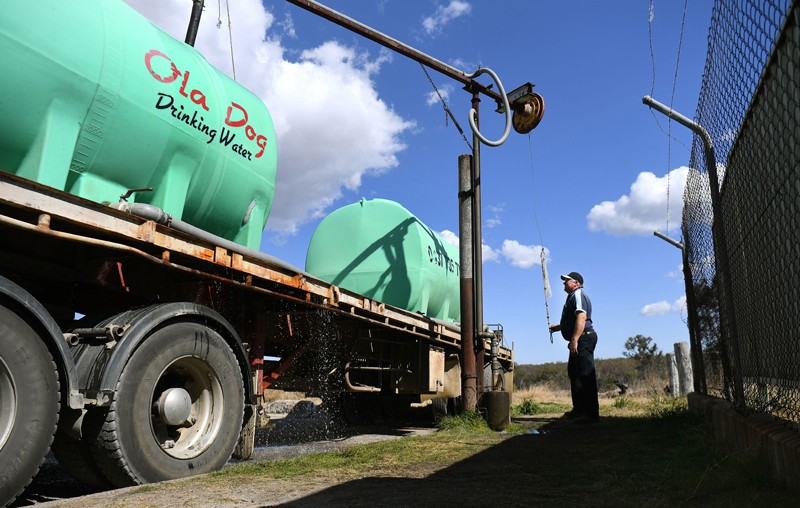Cecilia Tortajada &
Contact
Search for this author in:
Pierre van Rensburg
Contact
Search for this author in:
Drinkable water is becoming increasingly scarce. Population growth, pollution and climate change mean that more cities are being forced to search for unconventional water sources1. In a growing number of places, drinking highly treated municipal wastewater, called ‘reused water’, has become the best option — and, in some cases, the only one (see ‘What is reused water?’).
But anxieties about reused water, often heightened by sensational media coverage, have prevented several projects from going ahead. Some people are concerned that reused water will contain more pathogens and chemicals than drinking water sourced from lakes or rivers. Others are simply disgusted by the idea of consuming water that has passed through toilets and drains before being treated.
Around two billion people now live in countries with ‘high water scarcity’ — mainly in northern Africa and western, central and southern Asia2. With the global population predicted to increase from 7.7 billion today to 10 billion in 2050 — an estimated 70% of whom will live in urban areas — the demand for safe drinking water is set to rise drastically. According to a 2019 United Nations assessment, water demand in general is likely to increase by 20% to 30% between now and 20503.
Thus, conserving water is paramount. Supply infrastructure needs to be improved and better managed, including through the use of smart sensors and other technologies. Economic instruments, such as appropriate pricing, can boost efficient usage. Legislation needs to be implemented to lessen pollution. And all sectors — public and private — need to be educated about the importance of saving water, as does society more broadly.
High on the list should be efforts to investigate the benefits and risks of drinking reused water, including ways to make it more acceptable to consumers.
Public perception
Opposition from citizens has stalled several projects aimed at providing people with reused drinking water over the past two decades.
In 2000, the Los Angeles Daily News ran an article titled ‘Tapping toilet water’ about the East Valley Water Recycling project that had begun in the San Fernando Valley in Los Angeles, California, in 1995. People in the region were worried that the water, which they thought would be supplied only to those living in low-income areas, would be unsafe. The project was politicized by mayoral candidates, and the Los Angeles Department of Water and Power, which had proposed the project, eventually decided not to implement it. Since then, the reused water has been used only in irrigation and industry4.
In Queensland in Australia, residents successfully opposed a reuse project in Toowoomba in 2006 and the Western Corridor Recycled Water Scheme in southeastern Queensland in 2009, even while the country was experiencing the most severe drought since records began.
In Toowoomba, 62% of around 95,000 people voted against the project, largely because of safety concerns and fears that it would harm industries including tourism, food processing and property sales5. The Western Corridor Recycled Water Scheme cost Aus$2.4 billion (US$1.6 billion) to construct and aimed to produce up to 230,000 cubic metres of water per day to cover around 30% of southeastern Queensland’s water supply needs. But in 2009, following political pressure and a break in the drought, it was decided that the scheme would produce drinkable reused water only when the levels of the reservoir (where the reused water would be stored) fell below 40% of full capacity6.
Public scepticism over water safety is not completely unwarranted. In the United States and Canada, for example, there are still communities that lack access to safe drinking water — predominantly among low-income and minority ethnic populations7. In several cases, drinking water has been shown to be unsafe for the population, such as in Flint, Michigan, in 2014, and in several cities in Canada this year. In all of these instances, the water was found to contain higher concentrations of lead than those deemed safe by the regulatory authorities. In October last year, testing revealed that nearly 300 drinking-water wells and other water sources in California contain traces of chemicals known as PFASs (per- and poly-fluoroalkyl substances) that have been linked to certain cancers and other health problems.
Currently, however, reused drinking water is actually subject to stricter regulations, monitoring, assessments and auditing than standard drinking water.
Image enhancement
Three steps would improve the image of reused water.
Do more research. Wastewater contains hundreds of known chemical and pathogenic contaminants that, if not treated properly, can cause serious acute and chronic diseases, such as cholera or typhoid. Also, new chemicals are continually being introduced to the market, and new strains of bacteria and viruses discovered. Investigators at universities and those working for water-utility companies must study, quantify and effectively mitigate any emerging risks, and must keep appraising the overall benefits and costs of reused water on both human and environmental health.
Especially as technologies for detection become more sensitive, more affordable and widely available, the presence of pathogens and chemicals must be continuously monitored (by daily or even more frequent testing8) to protect the public from problems that might emerge9. Chronic risks from long-term exposure to low levels of toxic chemical substances are just as important to track as acute risks resulting from a one-off exposure10.
In middle- and high-income countries, drinking water, whether or not it is reused water, must meet national, regional and local health standards (or whichever apply) for pathogens, chemicals and any other types of contaminant8. So far, water agencies in cities using reused water have been able to meet these standards — through the use of multiple barrier-treatment steps from chemical to microbial, through real-time monitoring of microbes and chemicals, and by using various risk-management strategies throughout treatment and distribution11,12.
Improve public outreach. Water-utility companies must develop more comprehensive strategies on information dissemination, public consultation, education and engagement.
Community engagement is not — and must never be perceived to be — a means to convince the public that certain projects should go ahead. Rather, it should be about setting up platforms, so that people’s concerns can be heard and addressed early on, even if that means modifying plans.
Some successful projects can offer a model. In the 1990s, for instance, the city of San Diego in California planned a water reuse project to reduce its dependence on water transfers from the Colorado River and other sources. The project was initially supported by the public. But that support fell away for various reasons, including inconsistencies in the information provided by expert panels on the safety of recycled wastewater. Following the use of terms in the media such as ‘toilet to tap’ and ‘sewerage beverage’, and claims that the reused water would be supplied only to low-income communities, resistance was such that the city council converted the project to a non-drinkable scheme in 199913.
Yet San Diego still needed more drinking water. So in 2004, the company Public Utilities decided to develop more-comprehensive strategies for public outreach and education. Among the suite of approaches deployed were an online and telephone survey, research involving focus groups, opportunities for city staff to discuss the project with San Diego voluntary service organizations and others, and a dedicated website providing information.
These efforts paid off. In 2004, only 26% of those surveyed approved of water reuse. By 2012, 73% did. The city approved the ‘Pure Water San Diego’ project in 201314. It is expected to produce some 114,000 m3 of drinking water per day by 2023 and to supply one-third of the city’s water needs by 2035.
Implement projects where need is great. Competent water-utility companies should start implementing reuse projects in places where the need is greatest. They will need to have sufficient knowledge, technical know-how, staffing levels and financial capacity, and be operating in cities where there are strict water-quality regulations. Once such schemes have been proved safe and effective in places where the stakes are high, others will be more likely to support similar projects in their own communities.
Keys to success
The key to these strategies working is the continuous involvement of all stakeholders — from city mayors to national governments, from businesses and local health and medical boards to community and environmental groups, religious leaders and the media.
At least three important economic centres — Singapore, Windhoek in Namibia and Orange County in California — would not have progressed to where they are today without reused drinking water (see ‘Three successes’). In fact, without these reuse projects, the strict water rations that were likely to result could have had severe impacts on socio-economic development. Moreover, reused water can benefit streams, rivers, lakes, wetlands and aquifers, in part because the excess water from such projects that is returned to natural systems is of better quality than standard treated wastewater8.
Nature 577, 26-28 (2020)
References
- 1.
World Health Organization. Potable Reuse: Guidance for Producing Safe Drinking-Water (WHO, 2017).
- 2.
United Nations. Sustainable Development Goal 6: Synthesis Report 2018 on Water and Sanitation (United Nations, 2018).
- 3.
UNESCO. Leaving No One Behind: The United Nations World Water Development Report 2019 (UNESCO, 2019).
- 4.
US Bureau of Reclamation. Recycled Water Project Implementation Strategies. Technical Memorandum (US Department of the Interior & CH2MHILL, 2004).
- 5.
Hurlimann, A. & Dolnicar, S. Water Res. 44, 287–297 (2010).
- 6.
Australian Academy of Technological Sciences and Engineering. Drinking Water Through Recycling: The Benefits and Costs of Supplying Direct to the Distribution System (ATSE, 2013).
- 7.
Patel, A. I. & Schmidt, L. A. Am. J. Public Health 107, 1354–1356 (2017).
- 8.
US Environmental Protection Agency & CDM Smith. 2017 Potable Reuse Compendium [EPA-CDM CRADA 844-15] (EPA, 2017).
- 9.
US Environmental Protection Agency Office of Water. Draft Framework for a Water Reuse Action Plan (EPA, 2019).
- 10.
US National Research Council. Water Reuse: Potential for Expanding the Nation’s Water Supply through Reuse of Municipal Wastewater (National Academy of Sciences, 2012).
- 11.
Water Research Foundation. Assessment of Techniques to Evaluate and Demonstrate the Safety of Water from Direct Potable Reuse Treatment Facilities [Web Report #4508] (Water Research Foundation, 2016).
- 12.
WateReuse Research Foundation. Framework for Direct Potable Reuse (WateReuse Research Foundation, 2015).
- 13.
Brouwer, S., Maas, T., Smith, H. & Frinjs, J. D5.2 Trust in Water Reuse: Review Report on International Experiences in Public Involvement and Stakeholder Collaboration [DEMOWARE Project D5.2] (KWR Watercycle Research Institute, 2015).
- 14.
The City of San Diego. Report to the City Council (City of San Diego, 2013).
- 15.
Rice, J., Wutich, A. & Westerhoff, P. Environ. Sci. Technol. 47, 11099–11105 (2013).
- 16.
van Rensburg, P. Int. J. Water Resour. D 32, 622–636 (2016).
- 17.
Tortajada, C. & Nambiar, S. Water 11, 251 (2019).
Source: Resources - nature.com







